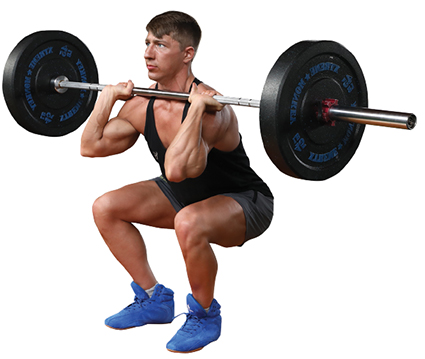Freak Fitness

As a strongman competitor, Darren has pulled 50,000 lb trucks and dead lifted 805 lbs. As a competitive bodybuilder, he has won Provincial Super-heavyweight & Overall titles. As President & CEO of FREAK Fitness, he has coached his clients to hundreds of Novice, Provincial/State, National, and IFBB Pro titles. Having been involved in the sport of bodybuilding for over 20 years, Darren has his finger on the pulse of the local and international bodybuilding scenes, and will be keeping you informed through his column, “Freak Fitness."

The Front vs. Back Squat Debate
Each type of squat offers distinct benefits, so you may be better off doing both!
You already know squats are your best exercise choice for putting on lower body mass or strength, and therefore should form the foundation of any aspiring physique athlete’s leg-training program. Heck, if your goal is to speed up your metabolism to burn more fat, squats will help you with that, too!
What makes them so special? When performed properly, squats engage nearly every muscle in your body—not just your legs. And with so much muscle recruitment, squats stimulate your body to produce more muscle-building hormones such as testosterone, GH, and IGF-1. And that, friends, is the only secret you need to know to making gainz!
But the squat doesn’t have to refer to just a single movement, the barbell back squat. Because in reality, squats are a familyof movements. And there are two beasts in there you should be considering when looking to build maximal size and strength: the front and back squat. Is one better? Let’s take a look.
How They Differ
1. Bar and Body Position. Back squats involve a barbell being placed on your upper back and traps. This bar position requires more upper body flexion to keep the barbell in place as you descend into the bottom position.
Front squats involve a barbell being held on the front of your shoulders, or what’s commonly called the “rack position.” The athlete must maintain a more uprightupper body posture to hold the barbell in place while performing the exercise.
 2. Muscles Emphasized. With the back squat, focus tends to be more on the posterior chain: hamstrings, glutes, and lumbar spine.
2. Muscles Emphasized. With the back squat, focus tends to be more on the posterior chain: hamstrings, glutes, and lumbar spine.
With the front squat bar position, focus tends to be more on the quads, core stabilization, and upper back.
3. Load and Safety. Because the bar position is easier to control in the back squat, generally speaking, more weight can be handled. And when you’re handling big loads, safety becomes a concern.
I strongly recommend you perform back squats only in a power rack with the safety catches positioned just below your lowest position in your range of motion. If there’s no power rack at your gym, then make sure you have a spotter when going for a PR.
 One thing I do like about front squats is that if you’re training alone with a max load, if you get stuck in the bottom you can simply dump the barbell forward and get out of the way. That’s something you can’t do with back squats unless you’re in a power rack.
One thing I do like about front squats is that if you’re training alone with a max load, if you get stuck in the bottom you can simply dump the barbell forward and get out of the way. That’s something you can’t do with back squats unless you’re in a power rack.
4. Limitations. One limitation of the back-squat bar position comes into play when you have a shoulder injury (i.e., rotator-cuff problem) or lack of shoulder flexibility. If it’s difficult for you to externally rotate and abduct your shoulders, it’ll be impossible (or at the very least painful) to hold the barbell in position.
One limitation of the front-squat bar position comes into play when you have a general lack of flexibility. Your wrists must be flexible enough to allow you to keep the barbell in your “rack position,” your upper back must be flexible enough to keep your chest up during the entire range of motion, and your posterior chain (glutes, hamstrings, knees, and ankles) must be flexible enough to allow you to squat low while keeping your knees in line with the direction your toes are pointing.
In the end, the question of which is better can’t really be answered. One is notbetter than the other.
Both squat variations provide great benefits, and I believe they should both be performed on a regular basis. If you do have shoulder issues or lack flexibility, get treated by the appropriate rehabilitation specialist to correct the problem and get back under the bar.
The time for debate is over: Get back to your squatting!
Get articles like this one delivered to your email each month by signing up for Muscle Insider’s mailing list. Just click here.

